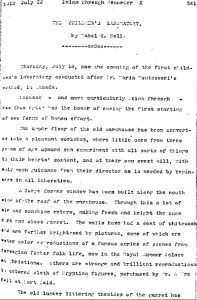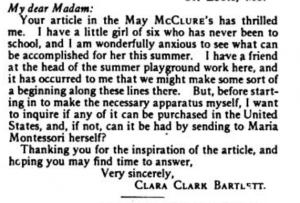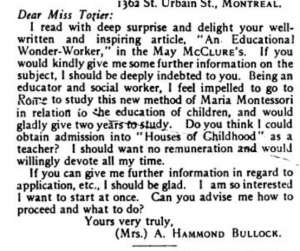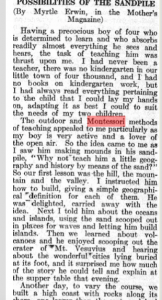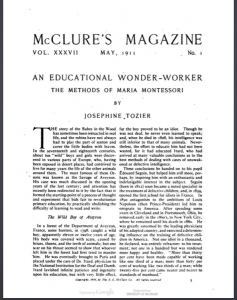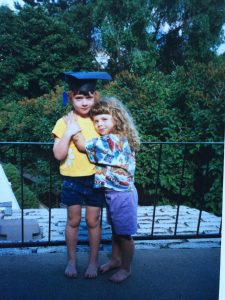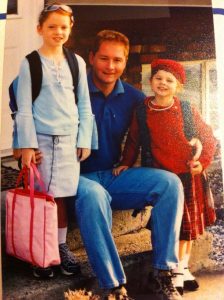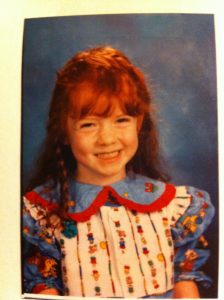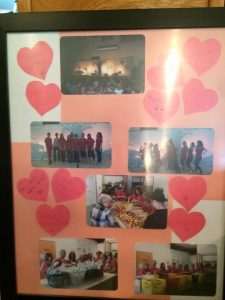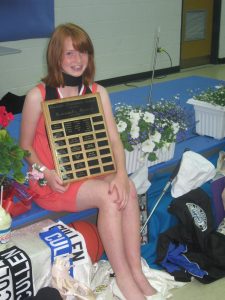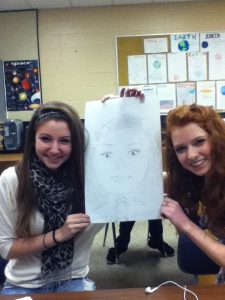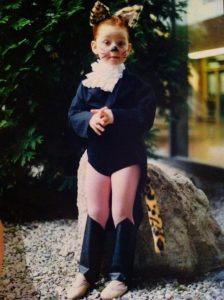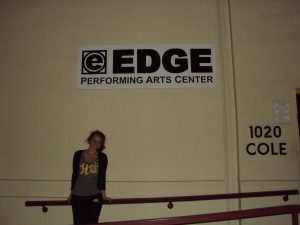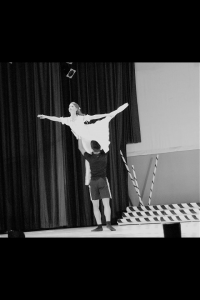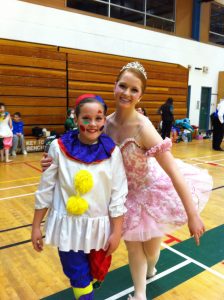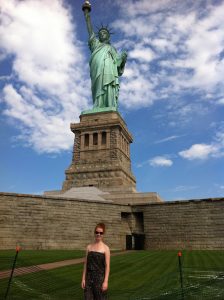The Dissemination of the First Wave Montessori Movement into America and Canada
Kyra Sinclair
HIST 3510
Tracy Penny Light
December 8, 2017
In this paper the dissemination of Dr. Maria Montessori’s pedagogy to America and Canada will be examined in terms of its importance to the reforming nations, as well as reasons for its failure in 1917. The first Montessori school in America was established October 1911 in Tarrytown, New York under the influence of American Montessori educator and pioneer, Anne Everett George.[1] Later, in July 1912, the first Montessori School in Canada was established by Alexander Graham Bell and wife, Mabel Bell, in Nova Scotia.[2] Dr. Montessori’s method served as a solution to poor and outdated qualities of North American education, one which was “grounded in close and insightful observations of children rather than in adult convenience and misconception.”[3] The Montessori system received vast interest from all parts of the world after McClures Magazine published it, but Dr. Montessori’s rigid standards and unwillingness to collaborate with other progressive education methods were a flaw in management and eventually led to the extinction of her methodologies.[4] This paper will outline the need for Dr. Montessori’s methods in American and Canadian societies, as well as challenges which inhibited her system to last between 1911-1917.
In this paper, it is important to recognize the coherence of Canadian and American societies and how although Canada was a self-governing British colony following the 1867 Constitution Act, they were still heavily influenced by America due to “geographical circumstances” and “historical affinities.”[5] Despite Canadian independence, “[they]… often borrowed [American] forms and modified their substance by simply minimizing their American character and making it be [their] own.”[6] For the purpose of this essay, the distinction of “American” does not confine itself to just the United States, it coincides with the experiences of Canada.
Maria Montessori was the first woman granted her Doctor of Medicine Degree by the University of Rome and founded her success through the results of her “‘mind-strengthening schools’ for feeble-minded children… in Rome.”[7] By taking a different path from the majority of American public schools, she taught her pupils to read and write so they could pass the same examinations that normal children of their age were expected to pass. Dr. Montessori stated her secret “was simple, she aided the children in their psychic development [while] normal children had been hampered and depressed.”[8] She based her methods on carefully prescribed techniques which were heavily psychological and grounded in the philosophy of idealism, use of specialized teaching materials,[9] and concern for the liberty of young children– she believed “all children could reach their social, moral, and intellectual potential if they had appropriate experiences in a prepared environment.”[10] Dr. Montessori abandoned her successful medical practise and appointment as a professor at the University of Rome and dedicated herself to the study of human development.[11] This diversion allowed her to dedicate time to her research, and lead workshops and lectures which allowed people to gain insight on her pedagogy. The effort put into ensuring her works were personally validated intrigued the general public and by 1911 “six reports of Montessori’s work appeared by educators and journalists, with the number [rising] to 54 in 1912.”[12] The dedication to, and success of, Dr. Montessori’s systematic work with feeble-minded children made her methodologies desirable to all nations because they were later adapted to aid capable children’s reading and writing.[13] By teaching the unteachable,[14] Dr. Montessori acquired a new identity– she became more than a physician, she was a valued educator.
Dr. Montessori offered a method that sought “change in the education system”[15] by introducing a “program of reform during a reform-minded age… [which would] mold a new generation of children [to] be independent [and] productive members of society.”[16] This method intrigued Americans because it was not only scientific and rational,[17] but was a solution to problems arising with children’s behavior following parental involvement in the workforce.[18] Following these social changes, the education system no longer depicted a useful teaching style for children of the twentieth-century. The Peels Prairie Provinces newspaper recollected an account where a member of the Alberta education committee stated “our schools are too rigid, with too much routine. The bright student is the one who can memorize easily, and recite glibly… we recognize horizontal ability, and the rare child with pronounced vertical ability too often is classed as rather dull….”[19] Another observation accounted for claimed “schools are factories in which raw products (children) are to be shaped and fashioned into products to meet the various demands of life.”[20] Due to Dr. Montessori’s belief that “the child…ought to be free, within the limits imposed, not by scholastic convention, but by social amenity;”[21] she encouraged American inquiry because it diverted from “rote learning and strict discipline [which] were no longer useful,”[22] and this was recognized by the majority of Americans.
Americans were among the first to gain interest in Dr. Montessori’s methods due to immigration and the age of efficiency at the beginning of the twentieth-century. The coinciding timing of mass public schooling with the age of efficiency led to the formation of a poor ideological foundation of traditional schooling and resulted in suboptimal learning conditions.[23] Leading educators contributed to the desire for change as they promoted mass schooling for the purpose of “[instilling] appropriate modes of thought and behaviour into children… not primarily [for] the acquisition of academic knowledge.” [24] Though there were many factors which influenced poor educational practises, immigration “was the primary factor in shaping the mass schooling movement”[25] because it over populated schools and influenced the abolishment of kindergarten in order to tend to the majority of students who were eight to twelve. This movement postponed the learning of children under seven[26] and led to the inquiry of Dr. Montessori’s Houses of Children[27] practise because it combined child care and learning, which compensated for the loss of maternal presence in the household and opportunity to attend kindergarten.[28] Child-centered progressive education was a popular phenomena in the early twentieth-century because children’s future success was desired; therefore scientific pedagogy became the only viable solution because facts, observation and experiment were used to prove its success.
Dr. Montessori’s alliance with McClures Magazine enforced her exposure to America through Josephine Tozier’s translation of her methods in the magazines 1911 issue.[29] Samuel McClure was the most influential journalist of his time and ran the McClures magazine which was the “journalistic herald of the Progressive Era.”[30] When he heard of Montessori’s system while travelling London in 1910 he recognized the opportunity that would come from promoting it; ones which would benefit himself, because he was going bankrupt, as well as Dr. Montessori because she would gain global recognition and the opportunity to advance American education.[31] McClure acknowledged the admiration his readers would have for Dr. Montessori’s promise that her method could “teach young children to read and write quickly, easily, and skillfully,”[32] and the response of the public proved him correct. Over 200 inquiries from just North Americans were received following the publication of the Montessori Method. This interest proved the American desperation for a new approach to education as they practically begged for more details on the pedagogy. Coming from mainly mothers, physicians, psychologists, principals and teachers, with questions covering the whole range of her work and experiment, Dr. Montessori decided have Tozier translate her apparatus so it would be attainable to Americans.[33] The consistent desire to learn more about her topic, gratitude given for her insightfulness, and willingness to travel to Rome for training, shows that Americans were eager for change.[34] By influence from America, Canadian’s gained interest in the Montessori system because they were experiencing similar problems of immigration and industrialization. The main Montessori advocates, Alexander Graham Bell and Margaret Potts saw the value of scientific pedagogy and established the first two Montessori schools in Canada in the early nineteenth-century.
American advocates of the Montessori method had a vast impact on Canadian inhabitants through newspapers, journals, and testimonies. A prominent influence, Dorothy Canfield Fisher, wrote a volume of her experiences training with Dr. Montessori in Rome which testified the relevance of the Montessori method to the average mother.[35] This expansion of the method to be more than a classroom aid spiked Canadian interest because it claimed to facilitate more than simply reading and writing, but also behavioral issues.[36] Alexander Graham Bell and Mabel Bell also impacted the inquiry of the Montessori method by establishing the first school in Canada on July 18, 1912 in Baddeck Nova Scotia at Beinn Bhreagh.[37] This school was managed by Mabel Bell and began with twelve attendees, seven of which were Bell grandchildren and five local children.[38] After the Beinn Bhreagh school had been operating for some time, Alexander Bell implemented weekly meetings to discuss and criticise the happenings in the classroom which were accounted for in the Beinn Breagh Recorder.[39] This “account received considerable notice in the Canadian Press, and was the means of evoking much interest in the Montessori method on Beinn Bhreagh and [its] neighborhood.”[40] Alexander Bell stated an important part of education within the schools is “’education not instruction’– a leading forth from within rather than a putting in from without;”[41] proving his appreciation for Montessori’s child-centered methods and development from scientific pedagogy. Alexander Bell was an inventor, scientist and educator who had little patience for the traditional teaching methods; therefore when opportunity struck for him to make a change, he took it. The Bell’s had a significant influence in changing the American education system by praising and expanding the pedagogy of the Montessori system into Canada.
Margaret Potts was also an advocate of the Montessori method and opened the second Canadian Montessori school in Calgary, Alberta in 1919. The Calgary Montessori School is the longest continuously operating Montessori school in North America and still stands to date.[42] It was established by Potts, then handed down to be administered by her daughter Vivienne Douglas, and is now operated by granddaughter Alison O’Dwyer who administers the present three Calgary campuses.[43] Potts was dedicated to learning the Montessori system, she attended Durham University in England in 1911 to obtain her Montessori training, met Dr. Montessori in San Francisco in 1915 to receive her blessing to operate her Calgary school, and travelled through North America to train teachers and help them establish Montessori schools.[44] The opening and operation of her school past 1917, shows not only the continued support for the Montessori method in her area, but also the progression of the Montessori system to tend to adolescents.[45] Photos within the Montessori Society of Canada’s webpage show children of all ages attending Pott’s school, which shows the evolution of Dr. Montessori’s methods to pertain to children of all ages rather than specifically kindergarten. Montessori’s system began as a replacement for kindergarten in Canada, but Potts dedication to maintain the existence of her school proves that the Montessori Method was indeed a successful education replacement.
The Montessori system was a solution to the many social changes in America, but the effort needed to receive its benefits and the criticisms to the authenticity of her scientific claims inhibited acclimation of her methodologies. Dr. Montessori saw the benefit of having educators and teachers working in close contact so parents could observe and be aware of educational aims. She emphasized putting “the schooling within the house,” thus putting a role on parents to hold “property of the collectivity” and maintain the accomplishments of the teacher.[46] This was an ambiguous task for parents because Dr. Montessori’s training was a very precise. [47] Her insistence the system be delivered in its entirety created problems because it entailed effort and training, she stated “teachers and children were not to modify any aspects of her method [because] any modification would render its scientific results.”[48] Emerging at a time when both parents worked so children could go to school and be supported made her requirements unrealistic for the average American family. The Montessori education system was a change for not only the child learning, but also the adult who obtained the role to maintain it. Once speculated, this method was seen as a lengthy process and an act of tiring parents because they did not have the patience to observe.[49] Many academic psychologists and progressive educators also criticised the work of Dr. Montessori as being “a mere fad promoted and advertised by a shrewd commercial spirit… [which was] accepted by the novelty loving American public.”[50] Many critics deemed Dr. Montessori was not experimenting in the true scientific sense because she lacked credible verification of a hypothesis in a controlled laboratory setting and her conclusions were unscientific and restricted.[51] The most prominent recollection of critique was William Heard Kilpatrick’s attack on her method through the publication of his book The Montessori System Examined in 1914, which “called the Montessori method a mid-nineteenth-century piece that was ‘fifty years behind’ modern educational thought.”[52] Despite these critiques Dr. Montessori asserted her “pedagogy was valid as it was based upon a system of logical, rational, and scientific inquiry.”[53]
The evolution of the first wave Montessorianism is very political because it was short lived, but quickly disseminated system. The Montessori method is the only curriculum model where a single individual was responsible for developing the conceptual framework as well as the template for its implementation; therefore following S.S. McClure’s exploitation of her method she could not maintain the extent of inquiry alone. World War I influenced the ebbing of the Montessori, and by 1917 almost all Montessori schools were non-existent, with the exception of Pott’s school.[54] There was a definite need for the Montessori method in America, despite the authenticity of her scientific pedagogy, her works were necessary in order to establish a successful foundation for education in the reforming nations. The extinction of the Montessori Method until the second wave in the 1960’s was a missed opportunity for the success of children’s learning. Twenty-first- century education system modifications prove that the Montessori Methods are a reliable solution to fix flawed and outdated systems, like the early nineteenth-century.[55]
[1] Gerald Gutek and Patricia Gutek, “Bringing Montessori to America: S.S McClure, Maria Montessori and the Campaign to Publicize Montessori Education,” University of Alabama Press, (2016): 11.
[2] “The First Montessori School in Canada- 1912 Beinn Bhreagh: The Nova Scotia Home of Alexander Graham Bell,” MSC Website, (2017). http://www.montessorisocietycanada.org/earlyhistory.html.
[3] Angeline Lilliard, “Montessori: The Science Behind the Genius,” New York: Oxford University Press, 2005, EBSCOhost (accessed December 1, 2017): 3.
[4] By 1913 teachers from as far as Australia travelled to Rome to receive training from Maria Montessori.
Samuel McClure, “My Autobiography,” McClures Magazine, (May 1914): 136.
[5] George Tomkins, “Some Aspects of American Influence on Canadian Educational Thought and Pratice,” McGill University, (1952): 6. http://digitool.Library.McGill.CA:80/R/-?func=dbin-jump-full&object_id=123841&silo_library=GEN01.
[6] Professor Fletcher of Dalhousie University recognized the “factor of proximity,” commonly known as the Ontario peninsula, where “ideas have been seized merely because they were very near and easily observed;” therefore playing and important role in Canadian- American relations and being used as a means for related educational thoughts, practices, and fears.
Ibid, 6, 11.
[7]Attended by children from all asylums for the feeble-minded within Rome.
Tozier, Josephine, “An Educational Wonder-Worker. The Methods of Maria Montessori,” McClure’s Magazine, 37, no. 1 (1911): 4.
[8] Tozier, “An Educational Wonder-Worker. The Methods of Maria Montessori,” 4.
[9] The use of carefully orchestrated materials influenced children that enrolled as young as two-years-old to be writing in cursive, and reading only a few months after.
Lilliard, “Montessori: The Science Behind the Genius,” 23.
[10] Larry Prochner and Nina Howe, “Early childhood care and education in Canada,” UBC Press, no. 1 (2000): 18.
[11] “Maria Montessori.” Montessori Society of Canada. (2017). http://www.montessorisocietycanada.org/overview.html
[12] Shuker, “The Historical Evolution and Contemporary Status of Montessori Schooling in New Zealand,” 67.
[13] Montessori based her work upon the use of concrete materials such as sensory based alphabets, which eased children to success in writing and subsequently reading.
Shuker, “The Historical Evolution and Contemporary Status of Montessori Schooling in New Zealand,” 44.
[14] These children were deemed “idiots” and classified as unteachable.
Rita Kramer, “Maria Montessori: A Biography,” University of Chicago Press, (1983): 89.
[15] Shuker, “The Historical Evolution and Contemporary Status of Montessori Schooling in New Zealand,” 67.
[16] Shuker, “The Historical Evolution and Contemporary Status of Montessori Schooling in New Zealand, 67.
[17] Ibid, 60.
[18] Christopher Clubine, “Motherhood and Public Schooling in Victorian Toronto,” in Sara Burke and Patrice Milewski (Eds.), Schooling in Transition: Readings in the Canadian History of Education, Toronto: University of Toronto Press, 2012: 115-126.
[19] “Our Educational Machinery Largely Outworn,” Reports Educational Committee of the U.F.A in Report to convention, The UFA, (1928): 14-15. Item: Ar01401.
[20] Lilliard, “Montessori: The Science Behind the Genius,” 8.
[21] Tozier, “An Educational Wonder-Worker. The Methods of Maria Montessori,” 10.
[22] “The First Montessori School in Canada- 1912 Beinn Bhreagh: The Nova Scotia Home of Alexander Graham Bell,” MSC Website.
[23] Lilliard, “Montessori: The Science Behind the Genius,” 7.
[24] Gaffield, “History of Education in Canada.”
[25] Chad Gaffield, “History of Education in Canada,” Canadian Encyclopedia, (2013) http://www.thecanadianencyclopedia.ca/en/article/history-of-education/.
[26] Cynthia Commachio, “‘The Rising Generation’: Laying Claims to the Health of Adolescents in English Canada, 1920-70,” Canadian Bulletin of Medical History, 19, no.1 (2002): 144.
[27] “The school performs the functions of a crèche– takes the children off the mother’s hands during working hours, and thus improves the economic position of the household… the children began to read and write simply because they thought they had ‘grown big enough.’”
Tozier, “An Educational Wonder-Worker. The Methods of Maria Montessori,” 4.
[28] Shuker, “The Historical Evolution and Contemporary Status of Montessori Schooling in New Zealand,” 30.
[29] Published May 11, 1911. Tozier was an advocate of the Montessori Method and trained under her.
Tozier, “An Educational Wonder-Worker. The Methods of Maria Montessori.”
[30] Gutek and Gutek, “Bringing Montessori to America: S.S McClure, Maria Montessori and the Campaign to Publicize Montessori Education,” 77.
[31] Ibid, 77-79.
[32] Shuker, “The Historical Evolution and Contemporary Status of Montessori Schooling in New Zealand,” 68.
[33] “Montessori Comes to North America 1911-1913.” MSC website. http://www.montessorisocietycanada.org/earlyhistory.html
[34] “Montessori Comes to North America 1911-1913.” MSC website.
[35] Dorothy Canfield, Fisher, “A Montessori Mother [microform].” Toronto: McClelland and Goodchild. (1912). https://archive.org/details/cihm_65480
[36] The Peels Prairie Province newspaper was a source for Prairie women to express their thoughts and concerns and receive feedback. “Peels Prairie Provinces.” University of Alberta. http://peel.library.ualberta.ca/search/?search=raw&pageNumber=1&field=body&rawQuery=Montessori&index=newspapers
[37] Beinn Breagh was the Bell’s former estate. They lived half the year in Washington D.C and spent the summers in Nova Scotia.
“The First Montessori School in Canada- 1912 Beinn Bhreagh: The Nova Scotia Home of Alexander Graham Bell.” MSC Website.
[38] There were 5 Grosvenor grandchildren and two Fairchild grandchildren.
“Alexander and Mabel– Montessori comes to Canada.” MSC website. http://www.montessorisocietycanada.org/earlyhistory.html
[39] Dr. Bell was fastidious about keeping detailed records of his work. The minutes of these frequent meetings are contained in the “Beinn Breagh Recorder” which account for experiment reports, verbatim records and the many home meetings.
Ibid.
[40] “Conference on the Education & Management of Children.” Beinn Bhreagh Recorder XI. (October 12, 1912). MSC website. http://www.montessorisocietycanada.org/earlyhistory.html
[41] Ibid.
[42] “Margaret Potts and the Calgary Montessori School- 1919.” MSC website. http://www.montessorisocietycanada.org/earlyhistory.html
[43] Ibid.
[44] Ibid.
[45] Photos within this page show children of varying ages participating in Pott’s school.
“Margaret Potts and the Calgary Montessori School- 1919.” MSC website.
[46] Shuker, “The Historical Evolution and Contemporary Status of Montessori Schooling in New Zealand,” 52.
[47] The method and its specialised materials were to be used in the precise manner outlined by Montessori.
Shuker, “The Historical Evolution and Contemporary Status of Montessori Schooling in New Zealand,” 60.
[48] Ibid.
[49] Maria Montessori, “Disciplining Children” in Montessori Comes to North America 1911-1913. 39. (1912): 99. http://www.montessorisocietycanada.org/earlyhistory.html
[50] Maria Montessori, “The Montessori Method: The Origins of an Education Innovation”, Rowman and Littlefield, ed. Gerald Gutek, (2004): 32.
[51] Ibid, 32.
[52] Ibid, 32.
[53] Shuker, “The Historical Evolution and Contemporary Status of Montessori Schooling in New Zealand,” 51.
[54] Montessori, “The Montessori Method: The Origins of an Education Innovation,” 34.
[55] Noted on the government page of B.C. the new education curriculum states:
“to prepare students for the future, the curriculum must be student-centred and flexible, and maintain a focus on literacy and numeracy…what we teach our students has been redesigned to provide greater flexibility for teachers, while allowing space and time for students to develop their skills and explore their passions and interests. The deep understanding and application of knowledge is at the center of the new model, as opposed to the memory and recall of facts that previously shaped education around the globe for many decades.”
“New Curriculum Info.” BC Government.
Bibliography
Clubine, Christopher, “Motherhood and Public Schooling in Victorian Toronto,” in Sara Burke
and Patrice Milewski (Eds.), Schooling in Transition: Readings in the Canadian History of
Education, Toronto: University of Toronto Press, 2012: 115-126.
Comacchio, Cynthia. “‘The Rising Generation’: Laying Claims to the Health of Adolescents in
English Canada, 1920-70.” Canadian Bulletin of Medical History 19, no.1 (2002).
“Conference on the Education & Management of Children.” Beinn Bhreagh Recorder XI.
(October 12, 1912). MSC website.
http://www.montessorisocietycanada.org/earlyhistory.html.
Fisher, Dorothy Canfield. “A Montessori Mother [microform].” Toronto: McClelland and
Goodchild. (1912). https://archive.org/details/cihm_65480.
Gaffield, Chad. “History of Education in Canada.” Canadian Encyclopedia. (2013).
http://www.thecanadianencyclopedia.ca/en/article/history-of-education/.
“Margaret Potts and the Calgary Montessori School- 1919.” MSC website.
http://www.montessorisocietycanada.org/earlyhistory.html.
“Montessori Comes to North America 1911-1913.” MSC website.
http://www.montessorisocietycanada.org/earlyhistory.html.
Montessori, Maria. “Disciplining Children” in Montessori Comes to North America 1911-1913.
- (1912): 99. http://www.montessorisocietycanada.org/earlyhistory.html.
Montessori, Maria. “The Montessori Method: The Origins of an Education Innovation,”
Rowman and Littlefield, edited by Gerald Gutek, 1-312, (2004).
“New Curriculum Info.” BC Government. https://curriculum.gov.bc.ca/curriculum-info.
“Our Educational Machinery Largely Outworn.” Reports Educational Committee of the U.F.A in
Report to convention. The UFA. (1928): 14-15. Item: Ar01401.
Kramer, Rita. “Maria Montessori: A Biography.” University of Chicago Press. (1983).
Prochner, Larry and Howe, Nina. “Early childhood care and education in Canada.” UBC Press 1,
(2000).
Shuker, Mary Jane. “The Historical Evolution and Contemporary Status of Montessori Schooling
in New Zealand, as an Example of the Adaption of an Alternative Educational Ideal to a
Particular National Context.” Degree of Doctor of Philosophy, Massey University, 2004.
Lilliard, Angeline Stoll, “Montessori: The Science Behind the Genius.” [electronic source] New
York: Oxford University Press, 2005. Thompson Rivers University CatalogeBook
Collection, (EBSCOhost)
Tomkins, George. “Some Aspects of American Influence on Canadian Educational Thought and
Pratice.” McGill University. (1952). http://digitool.Library.McGill.CA:80/R/-?func=dbin-jump-full&object_id=123841&silo_library=GEN01.
Tozier, Josephine. “An Educational Wonder-Worker. The Methods of Maria Montessori.”
McClure’s Magazine, 37, no. 1. (1911): 3-702.
